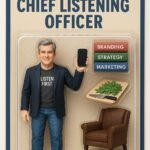In my consulting practice, I do a lot of discovery interviews with owners and employees. I peel back the layers of the onion to reveal the essence of the challenges they face. As an outsider, I can view their situation without the bias and employees tend to have in place. Often there is an orthodoxy or belief system everyone follows and agrees with without objection.
Discovery as an outsider is a chance at a fresh framing of the challenge.
My technique is structured to allow me to help me draw a picture of the situation and how a refreshed approach may help. Sometimes marketing isn’t the challenge. Often, it can be cultural.
Through discovery sessions, I attempt to get a more authentic look at the circumstances, not the company talking points or meaningless cliches. Whether it is a specific marketing challenge or a cultural topic, discovery sessions provide insights and a fresh view to see a situation.
I’m trying to discover, what’s the real issue? Why aren’t things humming along? My goal is to see if I can help show them an alternative path forward. Often, there is a misalignment among leadership and that’s the root cause that needs to be addressed.
Hello, This Way Please
It is easier to ask tough, probing questions when you are outside of the company if your approach is patient, human, and a good listener. I often will ask, how do you know this or why – to keep them explaining their viewpoint.
I conducted one of these sessions last summer and found that no one at the company was on the same page about what problems need to be solved.
The CEO believed that the problem was weak sales.
The VP of Sales thought the core issue was a product problem.
The VP of Marketing thought they needed to spend more money to raise awareness.
The Director of Products complained that it was a marketing issue.
And so on. Fingers were being pointed, and no one was clear about a solution.
It turns out the big problem was fear.
Everyone was afraid that the company’s core growth was slipping away. What used to work wasn’t working. The marketplace was shifting too fast for them to keep up. The CEO, an incredibly sharp woman in her late 40’s, was determined to fix the problem, but the team was stuck on what to do. And most troubling was that they weren’t hearing each other because they were all correct in their core assumptions.
From Discovery to Alignment
After about a dozen interviews, I got the senior team together, and we listed everything that they were afraid was happening or might happen in the near term.
We put it on the whiteboard and cluster it into buckets of fear. Most of the time we argued around what is sales versus marketing versus product problems. It was like on Seinfeld at Festivus, the airing of grievances. We got it out on the table after several hours.
Everyone took a few days after the session, to return and refine the problems and to assign a number from one to ten to get an urgency score.
From Alignment to a Plan
With a prioritized list, we built an action plan of things that needed to change, improve, and be reinvented.
As the fear dissipated, folks were able to act and work together in good faith. Instead of the blame game, they knew that they were all in it together if they were going to succeed. Fear often paralyzes the organization from acting.
We also did an exercise where each person needed to restate what they heard from their colleagues BEFORE sharing their idea. That helped get the team clearer on understanding each other.
It can take more than six months to help dissolve some of the anxiety as the team build a more realistic plan.
Three Takeaways:
- What is the core emotion felt within the culture of your company? Fear, excitement, anticipation, distrust, etc.? Culture kills strategy. Without a strong, resourceful trust-based culture, I don’t care how great your technology works. You are in for problems.
- Healthier cultures tend to have happier, more productive teams. It isn’t easy to solve problems with a clenched jaw and a tense atmosphere. Trust and the truth can act like lubrication to make a team work better together. I’m sure there are plenty of examples of fear-based, top-down companies that succeed. But good luck retaining employees in that environment.
- An outsider can offer radical honesty, that might get suppressed by a fearful environment. When someone can be frank, without a fear of reprisal, they may tell you the things you need to hear. Think of how only a best friend will be ruthlessly helpful when you need it because you know they have your best interest at heart.
Over the years, I have worked with many different companies in a range of cultures. I have first-hand experience working with a collaborative team that achieved great things together and companies that were laced with fear and intimidation.
Building a culture takes a strong leader who is smart and emotionally present. Willing to be bone-dry frank with constructive criticism but also understands the power of compassion to motivate people.
Is your organization aligned, growing, and as healthy as you’d like it to be?
Maybe you need a fresh perspective?
You can set up a time to chat with me about your marketing challenges using my calendar. Email me jeffslater@themarketingsage.com Call me. 919 720 0995. The conversation is free, and we can explore if working together makes sense. Watch a short video about working with me.
Photo by David Taffet on Unsplash





